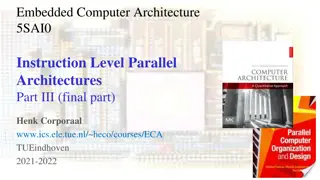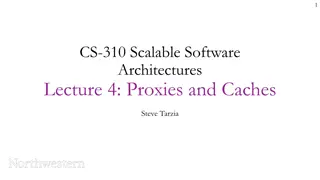Enhancing Healthcare Data Sharing with Service-Oriented Architectures
This paper explores how Service-Oriented Architectures (SOA) can be integrated with the HL7 Clinical Document Architecture to facilitate the sharing of Summary Care Records between healthcare information systems. It highlights the benefits of a federated architecture based on SOA and coding standards over a centralized record architecture for efficient data exchange. The system architecture focuses on enabling the sharing of medical records among healthcare providers, emphasizing the importance of the data layer and utilizing the OpenEMR open-source platform for patient information management.
Download Presentation

Please find below an Image/Link to download the presentation.
The content on the website is provided AS IS for your information and personal use only. It may not be sold, licensed, or shared on other websites without obtaining consent from the author. Download presentation by click this link. If you encounter any issues during the download, it is possible that the publisher has removed the file from their server.
E N D
Presentation Transcript
Mr. Peter Given Computing and Mathematics Department Institute of Technology, Tralee
Introduction This paper shows how Service Oriented Architectures can be combined with the HL7 Clinical Document Architecture to facilitate the sharing of Summary Care Records between health care information systems
Goals The solution demonstrates that A federated architecture based on SOA and coding standards is a viable alternative to a centralized record architecture for the sharing of summary care records
System Architecture The design describes a system that facilitates the sharing of documents from the electronic medical record between GPs and other healthcare providers (Out of hours, emergency etc) The architecture facilitates storing healthcare data locally and querying the data via an indexing mechanism.
Data Layer The Data layer involves the capture and storage of patient information in a GP Information System An Open source GP Information System was chosen to represent legacy open source GP Systems (openEMR)
OpenEMR A free open source medical practice management and electronic medical records application (www.openemr.org) Licensed under GNU GPL Operates in Linux, FreeBSD, MacOS X and Windows A client/server architecture written in PHP with a mySQL database downloadable as a WAMP application
OpenEMR The system is being used successfully at a number of sites [86,87,89]. A number of commercial companies are also supporting the software [88,89,90]. Not based on any EHR Standards but has some support for coding standards
Functionality of OpenEMR The application stores patient demographic data patient encounter information vital signs laboratory results prescriptions and allergy information. The system also allows the management of appointments and the generation of reports.
Interfacing to OpenEMR The project entailed building an Interface Engine was developed in order to extract: A Summary Care Record (SCR). This will hold patient demographic data along with known allergies and any medications prescribed in the last 6 months. A Prescription Record (PR). This will contain demographic details and prescription information that can be forwarded to a pharmacy system. A Patient Index for the SCR
Interfacing to OpenEMR Index SCR
Interfacing to OpenEMR The HL7 Clinical Document Architecture was chosen as the document architecture standard. The Interface Engine retrieves data from openEMRs databases and construct CDA conformant documents using the CDA schema
HL7 CDA The HL7 Clinical Document Architecture (CDA) is a document markup standard that specifies the structure and semantics of "clinical documents" for the purpose of exchange (HL7 website) A CDA document can include Text Images Sounds other multimedia content. Document-level, section-level and entry-level templates available The content of CDAs defined in the HL7 Reference Information Model and HL7 Data Types
CDA Structure <ClinicalDocument> ... CDA Header ... <StructuredBody> <section> <text>...</text> <Observation>...</Observation> <Observation> <reference> <ExternalObservation>... </ExternalObservation> </reference> </Observation> < /section> <section> <section>...</section> </section> </StructuredBody> </ClinicalDocument>
Summary Care Record as a CDA document The Summary Care Record Header Title, Time, Confidentiality Code, Version Number, Record Target (PatientRole, Patient Name, Gender, Birth Date), Provider Organization, Author, Custodian, Legal Authenticator, Encounter Information Section Allergies and Adverse Reactions Section Medications
Prescription Record as a CDA document The Prescription Record Header Title, Time, Confidentiality Code, Version Number, Record Target, Prescription Provider Organization, Author, Custodian, Legal Authenticator, Encounter, Section Prescription Information drug name, quantity, dosage, refills and notes
Interfacing to OpenEMR Index SCR
Implementing the interface The Interface Engine was coded using PHP/DOM and using a CDA document/section template schema The mapping from the openEMR database to the CDA schemas was incomplete as the database did not hold all the data specified in the CDA document schema. For example openEMR currently does not store clinical codes with separate parts of the medical record so the code fields in the CDA documents were left empty
Mapping inconsistencies Also the openEMR system stores dosing intervals as qid, bid, q3h while the CDA document needs these intervals to be represented as time periods and unit (e.g. 3 hours).
Designing the Communication Layer The Communication layer was designed in two parts. MPI Subsystem :The first part is the design of a distributed Master Patient Index Record Retrieval Subsystem : The second part of the design allows the user to retrieve the Summary Care Record or prescription record using a Service Oriented Architecture.
Master Patient Index Subsystem The Master Patient Index was designed on top of a peer-to-peer network called the GP Peer Group. A GP with the correct credentials can join and leave the peer network. The GP can then publish patient indices to the network. The index advertises the existence of a Summary Care Record for a patient and the endpoint address for that record
Patient Index The patient index is designed to hold the following information: document type etc The patients surname and first name The patient s date of birth The patient s PPS number The organisations id and name The endpoint where the full Summary Care Record can be found. The information to build the index was extracted from the openEMR system by the Interface Engine.
Generating Master Patient Index Index SCR
Generating a patient index from OpenEMR The index information is initially retrieved from the openEMR Clinical Information System using the data layer interface as described above The index information is wrapped in an XML message. A typical message is shown below:
Example Mater Patient Index <?xml version="1.0" ?> <SCR_Advert> <Document_CDA_Type>11488-4</Document_CDA_Type> <Document_Name>Summary Care Record</Document_Name> <Document_Description>Clinical Document</Document_Description> <Patient_Surname>Bloggs</Patient_Surname> <Patient_Firstname>Joe</Patient_Firstname> <Patient_DOB>19670425</Patient_DOB> <Patient_PPS>1</Patient_PPS> <Organisation_ID>6</Organisation_ID> <Organisation_Name>givens sugery</Organisation_Name> <Endpoint>http://localhost:8080/ccx/mySCRInterface</Endpoin t> </SCR_Advert>
Peer Advertisement The peer-to-peer software uses this information to generate a peer advertisement which appends the following header <?xml version="1.0" ?> <!DOCTYPE SCRAdvertisement> <SCRAdvertisement xmlns:jxta=http://jxta.org> <Advert_ID>urn:jxta:uuid- 59616261646162614E50472050325033272C475C1C344417800 08001</Avert_ID> MPI Infromation </SCRAdvertisement>
Peer to peer network A node can both publish to and search this network for indices. To search for a particular patients SCR a discovery message is propagated to all peers in the network.
Searching for a Patient Index The metadata contained within the index will improve the search results from the discovery process. Once a peer has retrieved the index for a patient the endpoint information is retrieved from the index. The second part of the communication layer will now use this endpoint to retrieve the actual Summary Care Record from the system in which it is stored.
Implementing MPI Application The MPI application itself consists of Java Swing components that implement a Graphical User Interface, along with calls to the JXTA API to join the GP Peer Group network and to publish/discover advertisements on the network.
Searching for a patient summary care records Once the user provides values the peer sends a discovery message to the other peers on the sub-network. Any Rendezvous peers on the local sub-network will further propagate the discovery message to other sub- networks they know about. Any advertisements that match the surname/PPS number are returned to the requesting peer. Clicking on a particular patient from this list will show the endpoint where the full Summary Care Record can be found. This endpoint information is now presented to the Web Service client to retrieve the patient s full Summary Care Record
Security in the Peer Network The JXTA configuration requires a username and password. A certificate may also be required. Once the peer starts up it can issue discovery messages to locate other peer groups it may wish to join. The peer groups enforce a second level of security. The user must supply a login name and password to join the GP Peer Group.
Record Retrieval Subsystem SOA is used to deliver the Summary Care Record A client program that knows the endpoint address can send a message to a Web Service on the GP site to retrieve the Summary Care Record as a CDA document
SOA Solution A Web Services Server called Cape Clear was used to build the SOA The Web Service was defined in WSDL using Cape Clear Studio. The Web Service was implemented in Java and uses the SOAP protocol at the messaging layer. A Web Services client was built in Java It generates SOAP requests which are sent to the sever and the response contains either a Summary Care Record or a Prescription Record
Retrieving the Summary Care Record The Web Service had two services; getSumaryCareRecord and getPrescriptionRecord. Both services require the patient s PPS number (a java.String) and the patient s surname (java.String). The service returns a CDA documents (also as a java.String) if one exists
Integrating the CDA record A reverse process to that taken to generate the data at the data layer could be followed in order to integrate the data with a local system. For this project it was enough to be able to view the record
Viewing the Record Once the record is saved the user can finally view the file. A standard XSL transform is attached to the file. The transform creates an HTML document that can be viewed by any browser. The document can also be printed out.
Application areas Out of Hours Services telephone triage etc Emergency Services Community Nursing
Conclusions: Advantages GP buy in can maintain their systems of choice (open source or commercial) GPs can maintain their records locally (pull model) Healthcare Standardization CDA for clinical document exchange Other summaries can be implemented easily Technology Standardizations SOA and Web Services Distributed MPI with location information
Conclusions: Challenges Technical barriers Each GP system requires an interface Engine to generate CDA documents GP database may not hold required information GP Communications System is a hybrid SOA/P2P solution Security Cost Distributed MPI with location information























